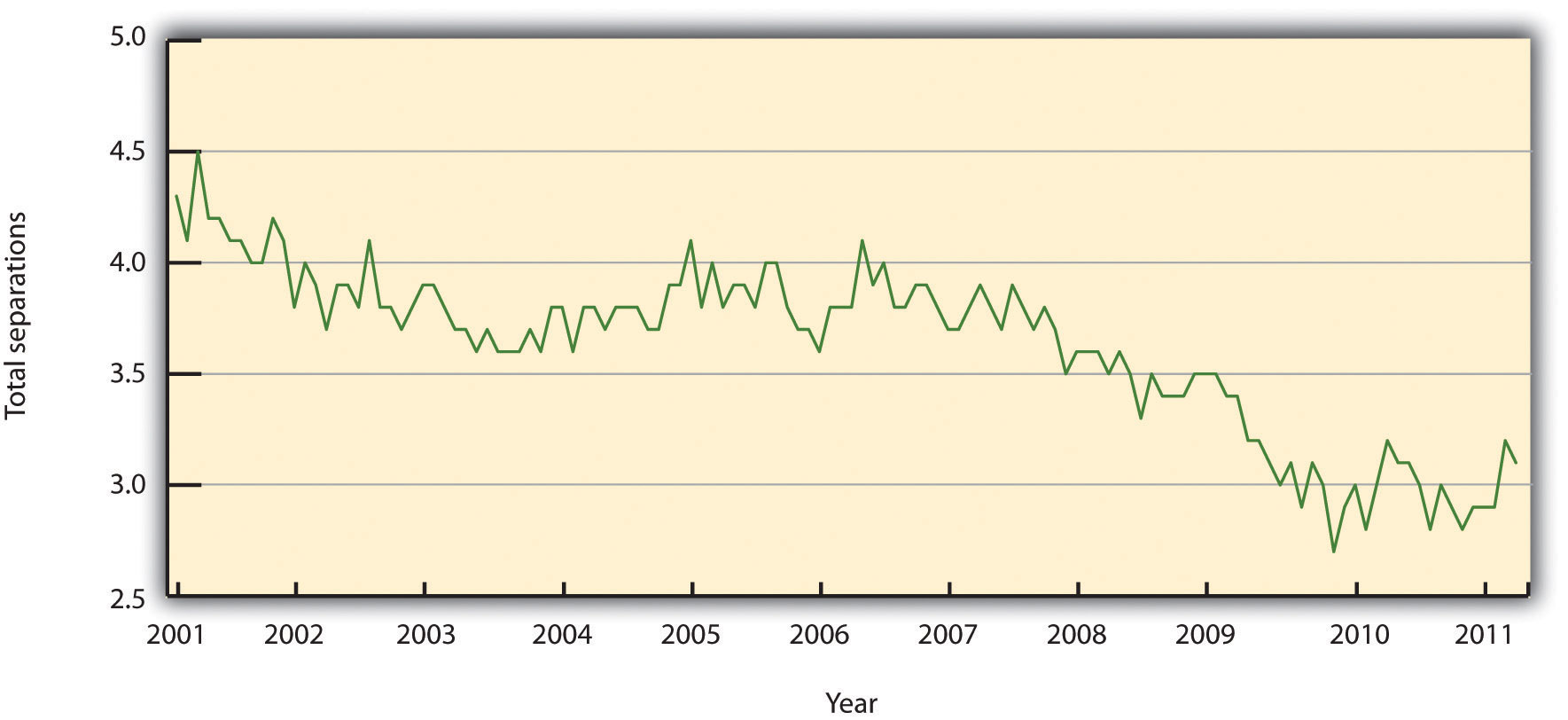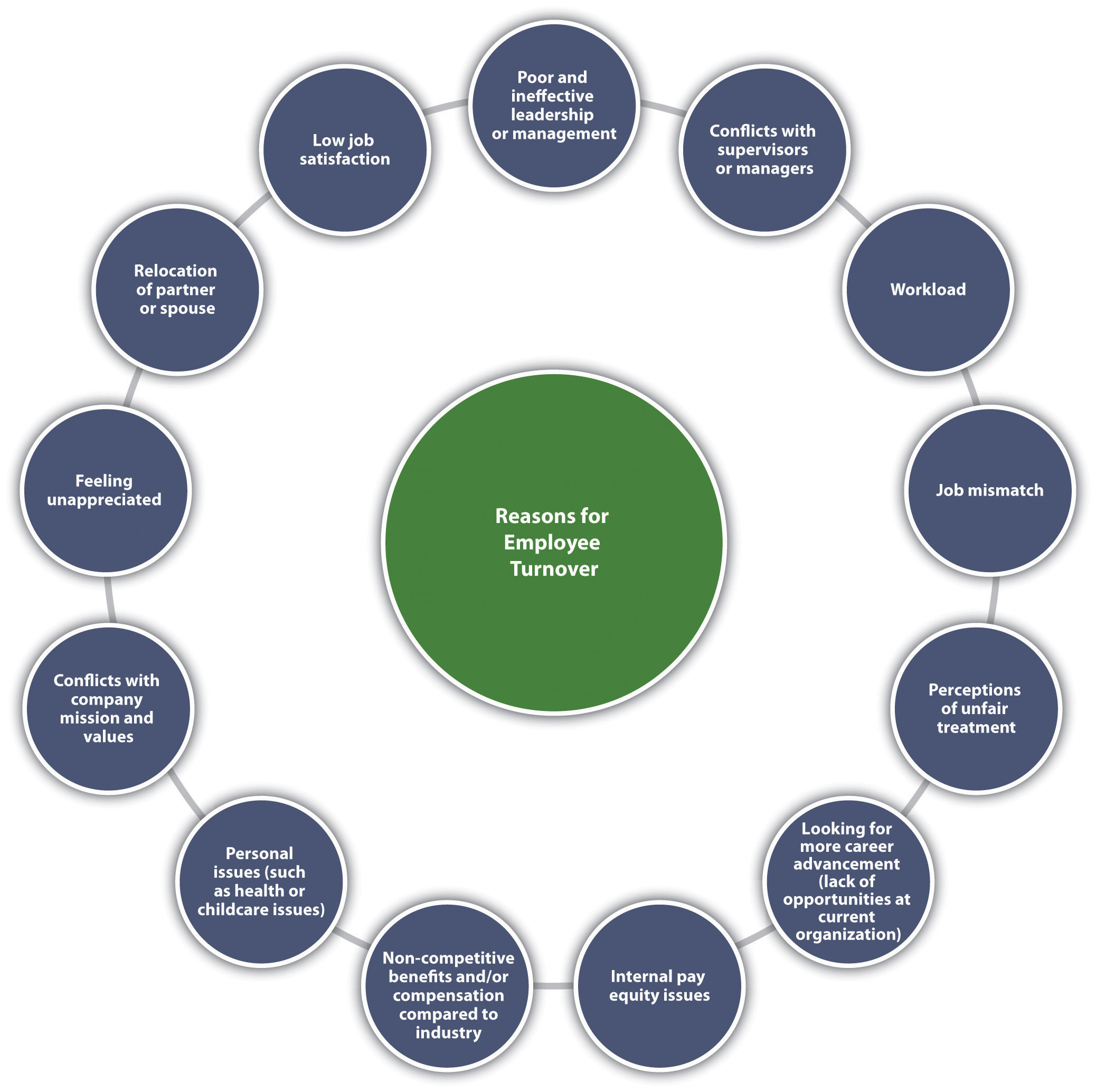Learning Objectives
- Be able identify the difference between direct and indirect turnover costs.
- Describe some of the reasons why employees leave.
- Explain the components of a retention plan.
According to the book Keeping the People Who Keep You in Business by Leigh Branham (Branham, 2000), the cost of losing an employee can range from 25 percent to 200 percent of that employee’s salary. Some of the costs cited revolve around customer service disruption and loss of morale among other employees, burnout of other employees, and the costs of hiring someone new. Losing an employee is called turnover.
There are two types of turnover, voluntary turnover and involuntary turnover. Voluntary turnover is the type of turnover that is initiated by the employee for many different reasons. Voluntary turnover can be somewhat predicted and addressed in HR, the focus of this chapter. Involuntary turnover is where the employee has no choice in their termination—for example, employer-initiated due to nonperformance. This is discussed further in Chapter 9 “Successful Employee Communication”.
It has been suggested that replacement of an employee who is paid $8 per hour can range upwards of $4,000 (Paiement, 2009). Turnover can be calculated by
separations during the time period (month)/total number of employees midmonth × 100 = the percentage of turnover.
For example, let’s assume there were three separations during the month of August and 115 employees midmonth. We can calculate turnover in this scenario by
3/115 × 100 = 2.6% turnover rate.
This gives us the overall turnover rate for our organization. We may want to calculate turnover rates based on region or department to gather more specific data. For example, let’s say of the three separations, two were in the accounting department. We have ten people in the accounting department. We can calculate that by
accounting: 2/10 × 100 = 20% turnover rate.
The turnover rate in accounting is alarmingly high compared to our company turnover rate. There may be something happening in this department to cause unusual turnover. Some of the possible reasons are discussed in Section 7.1.1 “Reasons for Voluntary Turnover”.
Figure 7.1 United States Yearly Turnover Statistics, 2001–11
Source: Data from Bureau of Labor Statistics, “Job Openings and Labor Turnover Survey,” accessed August 11, 2011, http://www.bls.gov/jlt/#data.
In HR, we can separate the costs associated with turnover into indirect costs and direct costs. Direct turnover costs include the cost of leaving, replacement costs, and transition costs, while indirect turnover costs include the loss of production and reduced performance. The following are some examples of turnover costs (Maertz & Campion, 1998):
- Recruitment of replacements
- Administrative hiring costs
- Lost productivity associated with the time between the loss of the employee and hiring of replacement
- Lost productivity due to a new employee learning the job
- Lost productivity associated with coworkers helping the new employee
- Costs of training
- Costs associated with the employee’s lack of motivation prior to leaving
- Sometimes, the costs of trade secrets and proprietary information shared by the employee who leaves
- Public relations costs
To avoid these costs, development of retention plans is an important function of the HR strategic plan. Retention plans outline the strategies the organization will use to reduce turnover and address employee motivation.
Table 7.1 Turnover Costs
| Direct | Indirect |
|---|---|
| Recruitment costs | Lost knowledge |
| Advertising costs for new position | Loss of productivity while new employee is brought up to speed |
| Orientation and training of new employee | Cost associated with lack of motivation prior to leaving |
| Severance costs | Cost associated with loss of trade secrets |
| Testing costs | |
| Time to interview new replacements | |
| Time to recruit and train new hires |
Costs of Turnover in Hospitality
” href=”http://www.youtube.com/watch?v=YQsTzbd9P24″ class=”replaced-iframe”>(click to see video)
This video provides an excellent illustration of how to measure the cost of employee turnover in the hospitality industry.
Reasons for Voluntary Turnover
Before we discuss specific details on retention planning, it is important to address the reasons why people choose to leave an organization to begin with. One mistake HR professionals and managers make is to assume people leave solely on the basis of their unhappiness with their compensation packages. Many factors can cause demotivated employees, which we discuss in Section 7.2.1 “Theories on Job Dissatisfaction”.
Once we find out what can cause voluntary turnover, we can develop retention strategies to reduce turnover. Some of the common reasons employees leave organizations can include the following:
- A poor match between the job and the skills of the employee. This issue is directly related to the recruitment process. When a poor match occurs, it can cause frustration for the employee and for the manager. Ensuring the recruitment phase is viable and sound is a first step to making sure the right match between job and skills occurs.
- Lack of growth. Some employees feel “stuck” in their job and don’t see a way to have upward mobility in the organization. Implementing a training plan and developing a clearly defined path to job growth is a way to combat this reason for leaving.
- Internal pay equity. Some employees, while they may not feel dissatisfied with their own pay initially, may feel dissatisfaction when comparing their pay with others. Remember the pay equity theory discussed in Chapter 6 “Compensation and Benefits”? This theory relates to one reason why people leave.
- Management. Many employees cite management as their reason for leaving. This can be attributed to overmanaging (micromanaging) people, managers not being fair or playing favorites, lack of or poor communication by managers, and unrealistic expectations of managers.
- Workload. Some employees feel their workloads are too heavy, resulting in employees being spread thin and lacking satisfaction from their jobs, and possibly, lack of work-life balance as a result.
We know that some people will move or perhaps their family situation changes. This type of turnover is normal and expected. Figure 7.2 “Common Reasons for Employee Turnover” shows other examples of why people leave organizations.
Figure 7.3
Cost of employee turnover can be high for both the bottom line and employee morale.
Jacklee – Frustrated man at desk – CC BY-SA 3.0.
As HR professionals and managers, we want to be sure we have plans in place to keep our best people. One such plan is the retention plan, which we will discuss in Section 7.2 “Retention Plans”.
Human Resource Recall
Do you feel your current or past organization did a good job of reducing turnover? Why or why not?
Key Takeaways
- Retaining employees is an important component to a healthy organization. Losing an employee is called turnover. Turnover can be very expensive to an organization, which is why it is important to develop retention plans to manage turnover.
- Voluntary turnover is turnover that is initiated by the employee, while involuntary turnover is initiated by the organization for various reasons such as nonperformance.
- Direct turnover costs and indirect turnover costs can include the costs associated with employee replacement, declining employee morale, or lost customers.
- Some of the reasons why employees leave can include a poor match between job and skills, no growth potential, pay inequity among employees, the fairness and communication style of management, and heavy workloads.
Exercise
- Perform an Internet search of average employee turnover cost and report findings from at least three different industries or companies.
References
Branham, L., Keeping the People Who Keep You in Business (New York: American Management Association, 2000), 6.
Maertz, C. P. Jr. and M. A. Campion, “25 Years of Voluntary Turnover Research: A Review and Critique,” in International Review of Industrial and Organizational Psychology, vol. 13, ed. Cary L. Cooper and Ivan T. Robertson (London: John Wiley, 1998), 49–86.
Paiement, N., “It Will Cost You $4,000 to Replace Just One $8 per Hour Employee,” Charity Village, July 13, 2009, accessed August 30, 2011, http://www.charityvillage.com/cv/research/rhr50.html.




